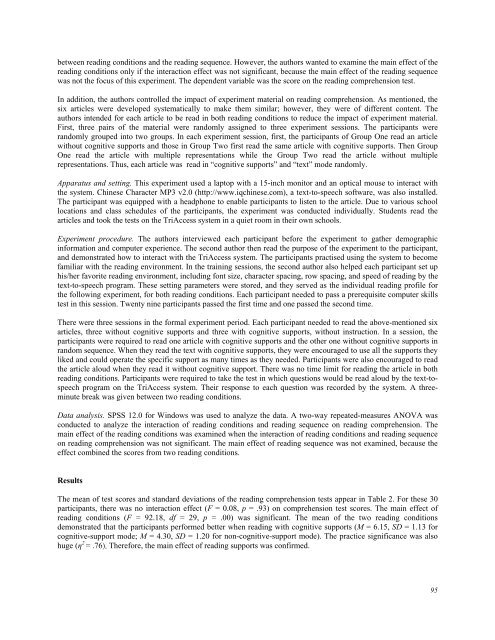October 2011 Volume 14 Number 4 - Educational Technology ...
October 2011 Volume 14 Number 4 - Educational Technology ...
October 2011 Volume 14 Number 4 - Educational Technology ...
You also want an ePaper? Increase the reach of your titles
YUMPU automatically turns print PDFs into web optimized ePapers that Google loves.
etween reading conditions and the reading sequence. However, the authors wanted to examine the main effect of the<br />
reading conditions only if the interaction effect was not significant, because the main effect of the reading sequence<br />
was not the focus of this experiment. The dependent variable was the score on the reading comprehension test.<br />
In addition, the authors controlled the impact of experiment material on reading comprehension. As mentioned, the<br />
six articles were developed systematically to make them similar; however, they were of different content. The<br />
authors intended for each article to be read in both reading conditions to reduce the impact of experiment material.<br />
First, three pairs of the material were randomly assigned to three experiment sessions. The participants were<br />
randomly grouped into two groups. In each experiment session, first, the participants of Group One read an article<br />
without cognitive supports and those in Group Two first read the same article with cognitive supports. Then Group<br />
One read the article with multiple representations while the Group Two read the article without multiple<br />
representations. Thus, each article was read in “cognitive supports” and “text” mode randomly.<br />
Apparatus and setting. This experiment used a laptop with a 15-inch monitor and an optical mouse to interact with<br />
the system. Chinese Character MP3 v2.0 (http://www.iqchinese.com), a text-to-speech software, was also installed.<br />
The participant was equipped with a headphone to enable participants to listen to the article. Due to various school<br />
locations and class schedules of the participants, the experiment was conducted individually. Students read the<br />
articles and took the tests on the TriAccess system in a quiet room in their own schools.<br />
Experiment procedure. The authors interviewed each participant before the experiment to gather demographic<br />
information and computer experience. The second author then read the purpose of the experiment to the participant,<br />
and demonstrated how to interact with the TriAccess system. The participants practised using the system to become<br />
familiar with the reading environment. In the training sessions, the second author also helped each participant set up<br />
his/her favorite reading environment, including font size, character spacing, row spacing, and speed of reading by the<br />
text-to-speech program. These setting parameters were stored, and they served as the individual reading profile for<br />
the following experiment, for both reading conditions. Each participant needed to pass a prerequisite computer skills<br />
test in this session. Twenty nine participants passed the first time and one passed the second time.<br />
There were three sessions in the formal experiment period. Each participant needed to read the above-mentioned six<br />
articles, three without cognitive supports and three with cognitive supports, without instruction. In a session, the<br />
participants were required to read one article with cognitive supports and the other one without cognitive supports in<br />
random sequence. When they read the text with cognitive supports, they were encouraged to use all the supports they<br />
liked and could operate the specific support as many times as they needed. Participants were also encouraged to read<br />
the article aloud when they read it without cognitive support. There was no time limit for reading the article in both<br />
reading conditions. Participants were required to take the test in which questions would be read aloud by the text-tospeech<br />
program on the TriAccess system. Their response to each question was recorded by the system. A threeminute<br />
break was given between two reading conditions.<br />
Data analysis. SPSS 12.0 for Windows was used to analyze the data. A two-way repeated-measures ANOVA was<br />
conducted to analyze the interaction of reading conditions and reading sequence on reading comprehension. The<br />
main effect of the reading conditions was examined when the interaction of reading conditions and reading sequence<br />
on reading comprehension was not significant. The main effect of reading sequence was not examined, because the<br />
effect combined the scores from two reading conditions.<br />
Results<br />
The mean of test scores and standard deviations of the reading comprehension tests appear in Table 2. For these 30<br />
participants, there was no interaction effect (F = 0.08, p = .93) on comprehension test scores. The main effect of<br />
reading conditions (F = 92.18, df = 29, p = .00) was significant. The mean of the two reading conditions<br />
demonstrated that the participants performed better when reading with cognitive supports (M = 6.15, SD = 1.13 for<br />
cognitive-support mode; M = 4.30, SD = 1.20 for non-cognitive-support mode). The practice significance was also<br />
huge (η 2 = .76). Therefore, the main effect of reading supports was confirmed.<br />
95

















